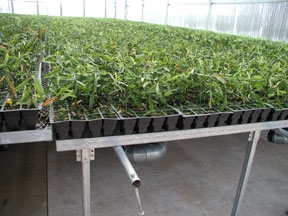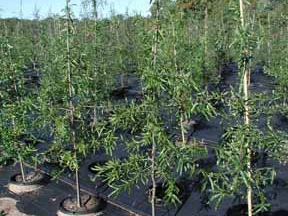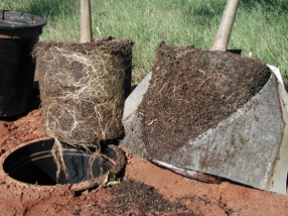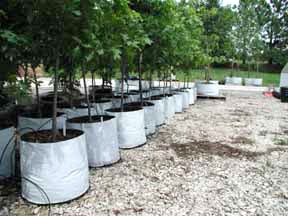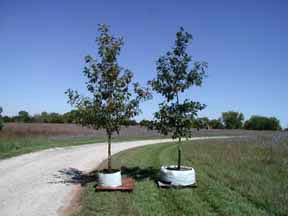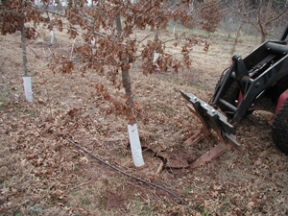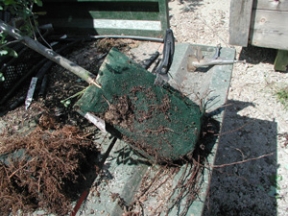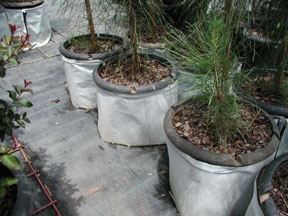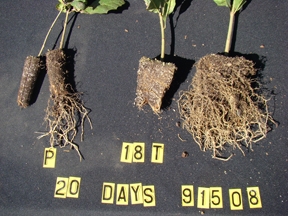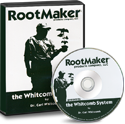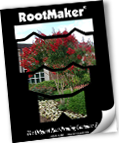“RootTrappers are the most amazing growing containers for our harsh desert conditions. With the water savings and the cooler root systems, over time they actually pay for themselves.”
You are here

"Bold Spring Nursery has planted Rootmaker tree liners from Rennerwood for over 15 years. In our nursery the trees establish rapidly and grow vigorously. Then they transplant readily when we sell them as B&B specimens. The Rootmaker/Rennerwood combination has proven successful for our nursery and beyond, in tree plantings from Texas to New England. Call Bold Spring Nursery today and learn how we can help make your project successful!"

"The reason I use the RootMaker product was out of frustration. You see I wanted to grow Bur Oak (Quercus macrocarpa) the dominant oak of the Midwest savannah.
The first problem was 30% plus mortality of seedling trees planted in our fields. Seedlings from the Midwest and liner stock from the west coast all performed poorly. I grew my own seedlings, which did better but only marginally.
The bigger problem was harvesting them. I remember this as if it was yesterday when a mechanical digger was digging a prize oak for an important client (all paying clients are important). The machine picked up that ball while the tree stood still. The tree's tap root was still anchored to the ground. The ball moved up the tree pruning off all the lower branches. Nothing feels worse when a saleable tree becomes non-saleable.
The next move was to hand dig. Hand digging is bad enough but bur oak are one of the worst. You had to wrap the ball with burlap every 6 to 8 inches and hope it will stay together when you are done. Planting bur oak in a good loamy soil virtually precludes a successful B&B digging.
I needed better roots. The first attempt was to root prune in the field. I believed with very few rare exceptions root pruning was a disaster.
A tree takes 1 to 2 years to recover from transplant shock. The tree is then root pruned and it takes another 1 to 2 years to recover. Somebody other than myself has a lot of time to sit and wait for product to come on line. A tree with a poor root system doesn’t improve significantly by root pruning. They should be thrown out.
I also tried drilling holes in roots for toothpicks laced with rooting hormone. I saw no significant increase in survivability. I did a lot of work for nothing.
Last but not least 35 to 40 per cent of the bur oak planted in my clients’ yards died. I would have to grow twice as many bur oaks to stay even with survival and go broke. I did not see a promising future in bur oak. I became very frustrated.
To this day I don’t know how I found out about Carl Whitcomb for there was no internet. I do remember obtaining four research books that he published in the late 70s and early 80s that were packed with research. The information in the research appeared to be a way to solve my bur oak problem. I took several field trips to Oklahoma State to learn more.
I went home to implement Carl's root maker system. I used soil mixes, milk cartons, fertilizer recommendations, and root bags. Bur oak responded by reducing mortality to less than 1 percent in the field. Mortality in my clients' yards dropped to about 5 percent. I would prefer no mortality all. I believe that is an objective all good plant people should work towards.
There is a saying out there that if something new comes out don’t be the first or the last to get it. I was one of the first. The root bag has gone through 6 or more revisions since the early 1980s. It is disappointing that we didn’t get it right the first time. The revisions were all improvements over previous products. The root bag of today is a first class product.
The changes from the 1980s to the present in propagation trays and containers have been equally as dramatic as the root bags. The improvements are truly improvements.
I have been using Carl Whitcomb's Root Maker Products for 20 plus years. I believe that this is the best growing system out there and believe me I am always looking."

"Dear Wayne,
Words are inadequate when it comes to telling you and Carl Whitcomb how much the RootTrapper II containers have meant to our tree farm the past few years. To our knowledge, there’s nothing in the industry that has ever come close to it, especially when it comes to the growth rates.
We consistently produce 3 ½ inch trees in three years, starting with plug liners right out of the green house. Factors we appreciate in addition to our superior growth rates are as the following stated below:
RootTrapper II:
a) They are an average of 23°F cooler in the summer months than the smooth black plastic standard containers. This gives us continued vigorous growth during the hot Texas summer months where other tree farms have a “shut down” in July and August. We do not see any root lose on the sun side like you always see 100% of the time with the black smooth wall plastic stuff. White is simply cooler than black!
b) We have NO CIRCLING ROOTS, but instead, PROLIFIC BRANCHES of the root system resulting in a dense fibrous rootball that impresses our landscapers and landscape architect customers. We water about 35 – 40 percent less than other tree farms.
These containers are gaining acceptance because our trees adapt into the landscape with NO OBVIOUS STRESS. They are easy to handle and transport, they do not damage trunks, and are easy for landscapers to remove.
The fibrous root systems increase absorption which increases top growth, caliper and produces much more branching. We are building and adding new customers every week. Trees grown in RootTrapper II are not an “inch or two better”, they are a MILE BETTER. Wayne, the green industry is changing. Customers today, especially the good landscapers, are better educated and have been exposed to more things than ever before. None of us in the business can afford to stop learning. Continuously “Getting Better” is absolutely necessary if you are going to survive.
We do thank you and Carl so much for all your contributions, especially for the superior RootMaker II container. The 5-30-45-65-95 gallons are the sizes that make it possible to separate Athens tree Farm from all the other conventional growers.
Because of our increased growth rates and superior trees we are now building our business by turning one time buyers and occasional buyers into customers for life. Before long we are going to stop advertising and calling as our repeat customers are buying our entire stock. Our customers love our quality and our prices!
This letter is getting to long and a little boring, but one other thing we’d like you to understand is how much money we save in labor because we do not have to do all that “bumping up” at every stage. We “bump up” one time only!
We come out of the greenhouse into 5 gallon RootMaker containers, then after about 1 year the trees are placed into 30, 45, or 65 gallon sizes and remain there for two years. The bigger liners go into 65 gallons and within 2 years, have grown to 3 ½ inches. The smaller liners are placed into 30 gallon containers for two years and reach 2 ¾ - 3 inches. The main point is, it’s only ONE 5 gallon bump up and the tree remains there until it is sold. The constant multiplying of the fibrous root system keeps the tree growing at a vigorous growth rate. The growth rate continues and the tops, with timely and correct pruning, become fantastic. The root systems as they multiply, produce so much more energy for the top. One root hits the sidewall, get’s trapped, and then branches, then the secondary and tertiary roots continue to multiply instead of circling. One root makes 5 roots, 5 roots makes 25 roots, 25 roots makes 125 and the system is off and running as energy is increased within the entire tree. And man…. THIS IS GROWTH!
I’ll close, but it’s difficult to stop talking about your product and all the benefits it has given us!
Again, thank you so much for putting us onto the RootTrapper II. If you ever have any customers interested in it, we’ll be more than happy to give them a tour and show how simple yet how incredible the results are.
Here’s hoping for the best for you and your family.
Sincerely,

"Rennerwood, Inc. has been growing in Rootmaker containers since the mid 1980’s. We have proven over the years that Rootmaker containers produce the absolute best possible root system available to our industry.
Over the past 26 years we have enjoyed comparing root systems by trialing every possible root manipulation container, including copper coated containers, on the market. To date we have not found a container that comes close to producing the root system on a tree as does the Rootmaker container. I challenge any container to produce the results we find with Rootmaker Products.
As a liner grower of over 80 varieties of trees and woody ornamentals we strive to be the best in the industry and to stay on top of our game. Rootmaker Products has given us that edge and we are grateful for the opportunity to work closely with Dr. Whitcomb and Rootmaker Products in producing the best liner available on the market today.
Rennerwood’s working relationship with the Best Growers in the industry is proof positive that Rootmaker grown liners out perform other container grown or bare root liners. If you are new to the industry or desire a better performing tree I invite you to compare Rootmaker grown liners.
I invite you to personally contact me if you have any questions about my commitment to excellence and in producing the best possible liner in the industry."

"Since the early 1990’s Arid Zone Trees® has implemented root management control procedures utilizing mechanical and chemical techniques to grow desert trees. AZT® asked the traditional smooth sided plastic container manufactures to produce containers that would reduce circling root development. In their marketing plan, tree growers concerned with quality amounted to a small market… of no significant monetary value to these manufactures. At least that was our interpretation of their reply.
After AZT® looked into the RootMaker products we immediately understood RootMaker recognized the importance of a trees sound root structure. The RootMaker products allowed our cloned selection of variety AZT® desert trees to develop a balanced well defined root mass to foliage mass ratio. At each trees transplant shift into a larger container, a fibrous root system is cultivated from the air root pruning. This fibrous root system quickly anchors into the next container size or fractured indigenous landscape soil profile, while providing healthy foliar growth.
AZT® visualized like every arborist, Landscape Architect and contractor that a tree planted should last a lifetime. With Dr. Whitcomb’s decades of research and development, and AZT’s® commitment to quality, we have chosen RootMaker containers to grow the best desert trees in the southwest.



